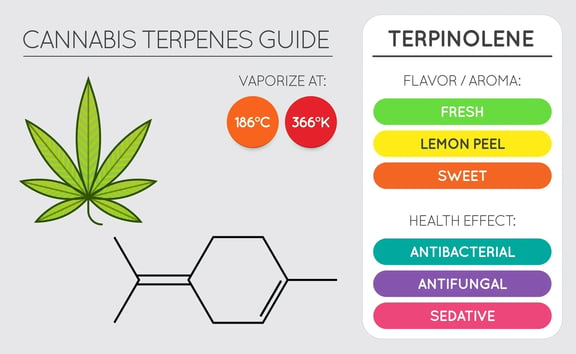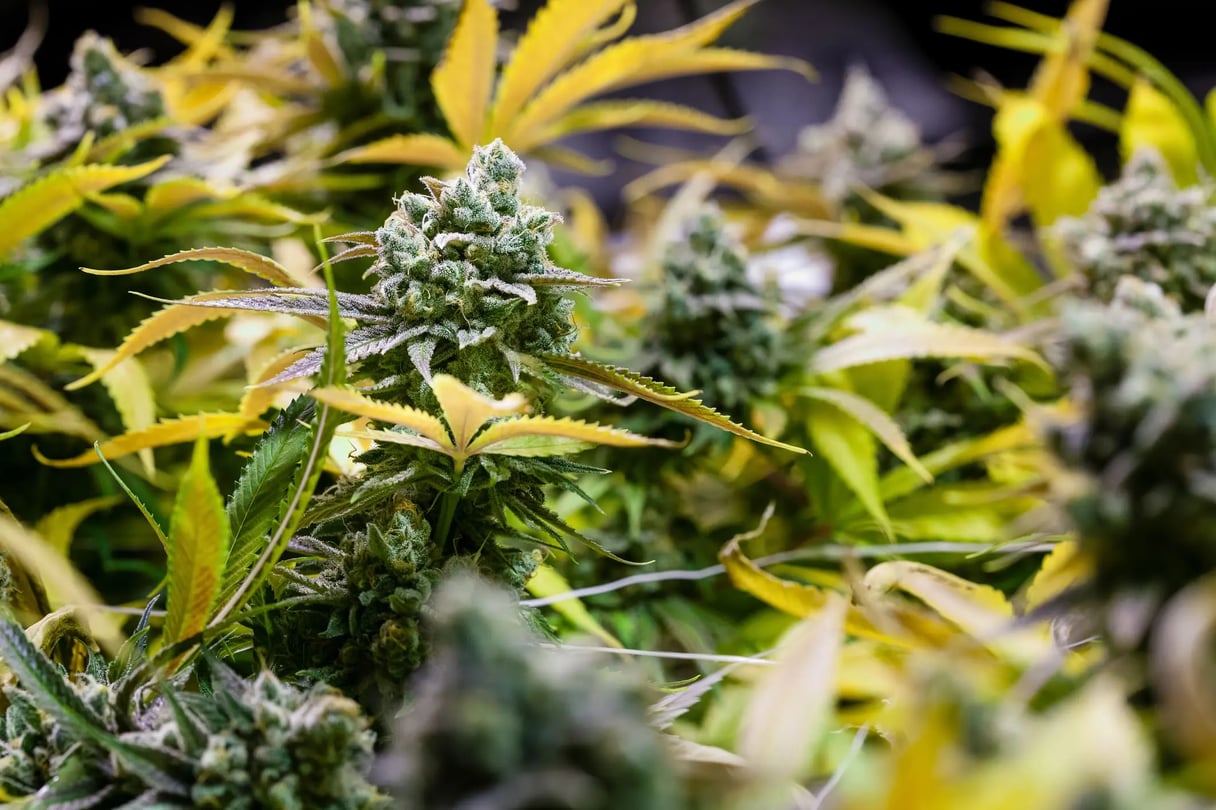Introduction
Capturing the Essence of Terpinolene
In the ever-evolving world of cannabis and its myriad of components, terpinolene stands out as a multifaceted terpene, often overshadowed by more prominent counterparts yet playing a crucial role in defining the nuanced experiences of cannabis enthusiasts. Terpinolene, a naturally occurring compound, weaves its magic not just in the realm of cannabis but across a spectrum of botanical wonders. Its presence, characterised by a symphony of piney, floral, and subtly citrusy aromas, marks it as a significant player in the aromatic profiles of many plants, including sage, rosemary, and conifer trees. This intricate interplay of scents and effects positions terpinolene as a key influencer in the world of terpenes, particularly within the cannabis landscape.
Venturing into terpinolene is akin to exploring a treasure trove of sensory experiences and potential benefits. As a terpene that’s prevalent in many cannabis strains, its impact is far-reaching, influencing not only the aroma and flavour of these strains but also contributing to the overall effects experienced by users. The exploration of terpinolene in cannabis opens up conversations around the synergy of terpenes and cannabinoids, a dance of compounds that defines the unique characteristics of each cannabis strain. With a focus on its role within cannabis, terpinolene’s journey from the subtleties of its scent to its broader implications in health and wellness becomes a narrative that’s as fascinating as it is educational, seamlessly blending the worlds of nature, science, and experience.

Unravelling the Mystique of Terpinolene: A Multifaceted Terpene
Scientific Insights into Terpinolene
Delving deeper into the scientific fabric of terpinolene unveils a terpene of remarkable versatility and complexity. At its core, terpinolene is a hydrocarbon classified as a monoterpene – a simple yet intriguing molecule that occurs in various natural sources. Its chemical structure lends itself to a plethora of interactions, particularly within the cannabis plant, where it coexists with other terpenes and cannabinoids, each contributing to the entourage effect – a synergistic phenomenon enhancing the overall efficacy and experience of cannabis. This intricate molecular dance is what makes terpinolene a subject of great interest, not only to cannabis connoisseurs but also to the scientific community keen on unravelling its full potential.
In the context of cannabis, understanding terpinolene extends beyond its molecular structure to its practical implications. Research has shown that terpinolene’s presence in cannabis strains influences their aroma and flavour profiles, often imparting a distinctive piney and floral character unmistakably alluring. But terpinolene’s role is more than just sensory. Its interaction with cannabinoids like THC and CBD contributes to the overall effects of the strain, playing a part in the nuanced experiences that define individual cannabis encounters. This relationship between terpinolene and other cannabis compounds presents a fascinating area of study, promising insights into how different terpenes shape the cannabis experience and offering a broader understanding of the plant’s therapeutic potential.
The Diverse Occurrences of Terpinolene
Terpinolene Beyond Cannabis: A Journey Through Nature
The journey of terpinolene takes us far beyond the familiar verdant leaves of cannabis, branching into a vast botanical landscape. This terpene, with its unmistakable aroma, is a common constituent in a multitude of plants, including sage, rosemary, and the towering conifers. Its presence is not just about adding a sensory delight but also speaks volumes about the ecological roles these plants play. Terpinolene’s natural diversity is a testament to its adaptability and importance in the plant kingdom, showcasing its role in shaping ecosystems and influencing human experiences.
In the grand tapestry of nature, terpinolene weaves its essence into more than just the aromatic profiles of plants. Its occurrence in various ecosystems hints at a broader significance, potentially affecting plant-pollinator interactions and serving as a natural defence mechanism against herbivores and pathogens. This makes terpinolene not just a compound of interest in the cannabis industry but also in the wider field of botany and ecology. Its widespread presence across different plant species underscores a fundamental truth – the interconnectedness of nature and the intricate roles played by compounds such as terpinolene.
A Symphony of Scents: Terpinolene’s Aromatic Profile
Decoding the Aroma: Terpinolene’s Signature Scent
The aromatic profile of terpinolene is as complex as it is enchanting. Often described as a blend of piney, floral, and slightly citrusy notes, terpinolene’s scent is a key contributor to the olfactory allure of many plants, most notably cannabis. This unique combination of aromas makes terpinolene a favoured component in perfumery and aroma therapy, where its scent is celebrated for its soothing and uplifting qualities. The versatility of its fragrance allows it to blend seamlessly into various aromatic compositions, creating a sensory experience that is both familiar and intriguing.
In cannabis, terpinolene’s aromatic influence is profound. It imparts a distinct character to strains, contributing to their appeal and user experience. This is where terpinolene truly shines – its ability to harmonise with other terpenes and cannabinoids in cannabis creates a bouquet of scents and effects that are both unique and diverse. For enthusiasts and connoisseurs, recognising the signature scent of terpinolene in a cannabis strain is akin to uncovering a hidden layer of the plant’s personality. This discovery enriches the cannabis experience. This intricate interplay of scents not only highlights the complexity of cannabis but also underscores the significant role of terpenes like terpinolene in defining the plant’s identity.
Terpinolene in the Cannabis Spectrum
The Role of Terpinolene in Cannabis Strains
In the diverse world of cannabis, terpinolene occupies a special niche, contributing significantly to the sensory and therapeutic profiles of various strains. Its presence in cannabis is more than just an aromatic footnote; it plays a vital role in shaping the strain’s character, from its scent to its effects. Terpinolene-rich strains are renowned for their distinctive aroma profiles, often marked by a complex interplay of piney, floral, and subtly citrus notes. This terpene doesn’t just add to the sensory palette; it also influences the overall experience of the cannabis user, particularly in terms of the effects a strain might offer.
Beyond its aromatic contribution, terpinolene’s role in the entourage effect within cannabis is of significant interest. This phenomenon, where terpenes and cannabinoids interact synergistically, enhances the overall therapeutic potential of the plant. Terpinolene, in conjunction with cannabinoids like THC and CBD, can modulate the effects of a strain, potentially altering its psychoactive impact or bolstering its health benefits. This synergy underscores the importance of terpinolene in the broader context of cannabis consumption, where understanding individual terpenes can lead to more tailored and effective cannabis experiences.
The Entourage Effect: Terpinolene’s Harmonious Interplay
Terpinolene in the Synergistic Dance of Cannabis Compounds
In the intricate ballet of cannabis compounds, terpinolene plays a pivotal role, contributing to the famed ‘entourage effect’. This phenomenon, where various cannabis components work in harmony to enhance the plant’s overall impact, sees terpinolene as a significant contributor. Its interaction with cannabinoids like THC and CBD, alongside other terpenes, creates a symphony of effects that transcend the capabilities of each compound alone. Terpinolene’s unique chemical properties can modify the psychoactive effects of THC, potentially reducing anxiety and paranoia while also enhancing the medicinal properties of CBD. This synergy showcases the complexity and potential of cannabis, making terpinolene a key player in understanding and leveraging the plant’s full potential.
“Terpinolene’s role in the entourage effect extends beyond just cannabinoids; it also interacts with other terpenes, enhancing the sensory experience and potentially the therapeutic benefits of cannabis,” explains Dr. Ethan Russo, a renowned cannabinoid researcher – Source: Dr. Ethan Russo’s Research on Cannabis Compounds.

Beyond Cannabis: Terpinolene’s Versatile Roles
Terpinolene in Everyday Life: From Fragrances to Flavours
Terpinolene, a terpene celebrated in the cannabis world for its unique characteristics, extends its influence far beyond. This multifaceted compound finds a place in our daily lives, notably perfumery and gastronomy. Its distinct aroma, a blend of citrusy, floral, and piney notes, has made it a sought-after ingredient in fragrances and flavours. In perfumery, terpinolene adds a fresh, invigorating dimension to scents, often a key component in citrus and woodsy fragrance profiles.
In the culinary sphere, terpinolene’s role is equally significant. Its ability to impart a subtle yet distinctive flavour makes it a valuable addition to various food and beverage products. From the zest in fruit juices to the exotic twist in spiced dishes, terpinolene’s presence enhances the sensory experience. Its use in food flavouring showcases its safety and versatility, making it a staple in the flavour industry.
The Therapeutic Promise of Terpinolene
Unveiling Terpinolene’s Health Benefits
Exploring terpinolene’s therapeutic potential unveils a treasure trove of health benefits. Known for its soothing properties, terpinolene is increasingly recognised for its ability to promote relaxation and aid in sleep. This terpene has also shown potential in reducing the risk of heart disease, owing to its antioxidant properties, which combat oxidative stress and inflammation – key factors in cardiovascular health.
In addition, terpinolene exhibits antimicrobial properties, making it a candidate for use in natural preservatives and healthcare products. Its ability to inhibit the growth of bacteria and fungi underscores its potential in various applications, from food safety to personal care products.
Historical Context and Traditional Uses
Tracing Terpinolene Through Time and Cultures
Terpinolene’s journey through history is as rich and varied as its applications. Traditionally, it has been used in folk medicine across various cultures, leveraging its therapeutic properties. In some cultures, it was valued for its sedative effects in herbal remedies to promote relaxation and alleviate insomnia. Terpinolene’s presence in plants like sage and rosemary also links it to historical uses in aromatherapy and herbal medicine, where these plants were employed for their calming and soothing properties.
Moreover, terpinolene has played a role in traditional culinary practices and is used for its flavour-enhancing properties. Its inclusion in various cuisines demonstrates not only its versatility but also its longstanding integration into human life and culture.
Case Studies and Practical Applications
Terpinolene in Action: Real-World Examples
Real-world applications of terpinolene showcase its versatility and effectiveness. In agriculture, terpinolene-rich plants are used as natural pest repellents, offering an eco-friendly alternative to synthetic chemicals. This application underscores the terpene’s potential in sustainable farming practices.
“Innovative farming techniques are harnessing terpinolene’s natural pest-repelling properties, contributing to more sustainable agriculture,” explains an expert in sustainable farming – Source: Sustainable Agriculture Today.
In the cosmetic industry, terpinolene’s antimicrobial and pleasant aromatic properties make it a valuable ingredient in skincare and beauty products. Its incorporation in creams and lotions illustrates how nature’s bounty can be harnessed for personal care, aligning with the growing demand for natural and sustainable beauty products.

Environmental and Agricultural Aspects
Cultivating and Harvesting Terpinolene: Environmental Considerations
Terpinolene, a terpene commonly associated with cannabis, holds a unique standing not only in its aromatic and therapeutic profile but also in its cultivation and environmental aspects. This terpene, known for its minimal environmental impact during cultivation, has become a sustainable choice for eco-conscious growers, contributing significantly to environmentally friendly agricultural practices. This aspect is particularly relevant given the increasing global focus on sustainable agriculture and the need for practices that do not deplete natural resources or harm the environment.
The agricultural narrative of terpinolene-rich plants is equally compelling. Innovations in agricultural practices have enhanced the yield of these plants, contributing to a more efficient production system. This efficiency is critical in a world where demand for natural products, including those from cannabis, is ever-increasing. Moreover, the adaptability of terpinolene-producing plants to a variety of climates is a testament to their potential for global cultivation, offering opportunities for diverse agricultural ventures.
User Experiences and Anecdotal Evidence
Personal Accounts: Terpinolene in Everyday Use
When exploring the world of cannabis terpenes, particularly terpinolene, user experiences and anecdotal evidence form an integral part of understanding its impact. Users often report a significant stress-relieving effect when using terpinolene-rich strains. This anecdotal evidence aligns with the terpene’s known calming properties, providing a first-hand glimpse into its potential therapeutic benefits.
Additionally, anecdotal evidence suggests that terpinolene may play a role in enhancing mood and providing relaxation. Its unique scent is often described as uplifting and rejuvenating, especially in aromatherapy applications. This aspect of terpinolene underscores its versatility and potential as a holistic wellness aid, transcending its role in cannabis and entering the broader realm of natural health solutions.
Comparative Analysis with Other Terpenes
Terpinolene Versus Other Terpenes: Understanding the Differences
Terpinolene, a key player in the world of cannabis terpenes, exhibits distinct properties that set it apart from its peers. Its unique scent profile and effects differentiate it significantly from other terpenes. This uniqueness is crucial in understanding terpinolene’s specific role in the entourage effect and its impact on the overall cannabis experience.
Studies have shown that while some terpenes have energising properties, terpinolene is known for its calming effects. This contrast is vital for users and growers in selecting strains for specific needs and experiences. Understanding these differences helps in appreciating terpinolene’s unique contributions to the entourage effect, enhancing our grasp of its role within the complex world of cannabis.
Potential Risks and Side Effects
A Critical Look at Terpinolene’s Safety Profile
While terpinolene is celebrated for its therapeutic benefits, it’s crucial to consider its potential risks and side effects. Like any compound, terpinolene’s safety profile isn’t entirely without concerns. Users should know its effects, especially when used in high concentrations. Studies indicate that excessive use of terpinolene, particularly in concentrated forms, may lead to irritation or allergic reactions in some individuals.
Furthermore, when discussing terpinolene’s safety, it’s important to consider the context of its use. For instance, in the realm of cannabis consumption, the interaction of terpinolene with other cannabinoids and terpenes could modify its effects. This interaction necessitates a more nuanced understanding of its safety, particularly for individuals with specific health conditions or those taking certain medications.

Regulatory and Legal Landscape
Navigating the Legalities of Terpinolene Use
The legal landscape surrounding terpinolene, particularly as a component of cannabis, is complex and ever-evolving. Different regions have varying regulations regarding the cultivation, distribution, and use of cannabis and its derivatives, including terpinolene. Understanding these legal nuances is crucial for both consumers and producers. In some jurisdictions, the use of cannabis and its compounds, including terpinolene, is strictly regulated or even prohibited.
In addition to regional laws, the legal status of terpinolene is also influenced by its classification and the context of its use. For instance, terpinolene used in aromatherapy or non-cannabis products may be subject to different regulations than when it’s present in cannabis products. This complexity underscores the importance of staying informed and compliant with local laws and regulations.
Future Trends and Research Opportunities
Terpinolene: The Road Ahead in Research and Applications
The future of terpinolene research and applications is bright, with numerous avenues for exploration. As interest in cannabis and its compounds continues to grow, so too does the scientific curiosity surrounding terpinolene. Researchers are delving into its potential therapeutic applications, seeking to understand its effects on a deeper level. This ongoing research is not only opening up new opportunities for medical cannabis applications but also broadening our understanding of terpinolene’s role in the entourage effect within cannabis.
Moreover, the evolving landscape of cannabis legalisation and regulation is creating more opportunities for terpinolene research. As legal barriers are reduced, scientists have greater access to cannabis compounds for study. This increased accessibility is likely to lead to a surge in research, potentially uncovering new uses and benefits of terpinolene, both within and beyond the realm of cannabis.
Scientific Pursuits and Future Potentials of Terpinolene
Current Research and Unexplored Avenues
Recent research on terpinolene has delved into its anti-inflammatory and antioxidant properties, with studies suggesting it could play a role in reducing the risk of heart disease and certain cancers. One study highlights terpinolene’s efficacy in inhibiting the growth of cancer cells, showing promise for future oncological applications. However, these findings are preliminary and necessitate further exploration in clinical settings.
The intersection of terpinolene with other cannabinoids and terpenes in cannabis also opens new avenues for research. The potential synergistic effects, part of the ‘entourage effect’, could lead to breakthroughs in how we understand and utilise medical weed strains. The interest in terpinolene’s role in enhancing the sensory experience of cannabis is also noteworthy, suggesting future applications in the development of specific cannabis strains for therapeutic and recreational use.
Looking forward, there’s a growing call for more comprehensive, human-centred studies to understand terpinolene’s potential fully. The exploration into its safety profile, efficacy in various medical conditions, and optimal dosages are crucial next steps. The promising avenues of research beckon a future where terpinolene’s full spectrum of benefits can be harnessed, potentially revolutionising our approach to natural health solutions.
Terpinolene: A Recapitulation of its Multidimensional Impact
Reflecting on Terpinolene’s Journey from Nature to Science
Terpinolene, a terpene as intriguing as it is elusive, has journeyed from the understated corners of nature to the forefront of scientific research. Its presence in cannabis and a myriad of other plants has been known for ages, but only now are we beginning to grasp its full potential.
This terpene, renowned for its fresh, piney aroma with hints of floral and herbaceous notes, has been a key player in the fragrance and flavour industries. However, the recent surge in interest from the scientific community truly showcases its multidimensional impact. Studies suggest terpinolene’s role in reducing cancer risk, combating inflammation, and acting as an antioxidant, positioning it as a potential powerhouse in natural health solutions.
Yet, as we reflect on Terpinolene’s journey, we’re reminded of the vast uncharted territories. Its interactions with other terpenes and cannabinoids, the nuances of its effects in different strains of cannabis, and its potential in treating specific health conditions are areas ripe for exploration. The future of terpinolene research seems poised at an exciting crossroads, with the promise of discoveries that could reshape our understanding of natural therapeutics and the role of cannabis in medicine.
In sum, terpinolene’s story is one of an enigmatic natural compound stepping into the limelight of scientific curiosity. Its journey from the aromatic depths of forests and gardens to the meticulous scrutiny of laboratories reflects a broader narrative of rediscovering nature’s hidden gems. As science continues to unravel the mysteries of terpenes like terpinolene, we stand on the brink of a new era of understanding and utilising the natural world for human health and well-being.
Terpinolene FAQs:
-
Terpinolene is a naturally occurring terpene found in many plants, including cannabis. It’s known for its complex aroma, combining elements of pine, floral, herbaceous, and occasionally citrusy scents.
-
Terpinolene contributes a nuanced aroma profile to cannabis strains, often described as fresh, piney, and mildly floral. This terpene is a key player in defining the unique scent and taste of many cannabis varieties.
-
Preliminary research suggests Terpinolene may have several health benefits, including anti-inflammatory, antioxidant, and possibly even anti-cancer properties. However, further studies are needed to confirm these effects.
-
No, Terpinolene is also present in other plants such as sage, rosemary, apple, tea tree, and conifer trees. Its presence contributes to the distinctive scents and flavours of these plants.
-
Yes, as part of the entourage effect, Terpinolene can interact with cannabinoids and other terpenes in cannabis to potentially modify its overall effects, such as enhancing relaxation or mood elevation.
-
Terpinolene is less common than some other terpenes like Myrcene or Limonene. It’s usually found in lower concentrations, but it can still play a significant role in a strain’s overall profile.
-
Yes, due to its pleasant aroma, Terpinolene is used in aromatherapy and perfumery. Its scent is believed to have uplifting and soothing properties.
-
Terpinolene is generally considered safe, especially when used in typical amounts found in plants. However, like all compounds, excessive use may have adverse effects, and it should be used responsibly.
-
Terpinolene’s production and concentration can be influenced by environmental factors such as soil type, climate, and cultivation practices. Its natural role in plants can be part of their defence mechanism against pests.
-
Terpinolene is typically extracted from plant materials using methods like steam distillation or solvent extraction. This process isolates the terpene for use in various applications like essential oils, fragrances, and cannabis products.










